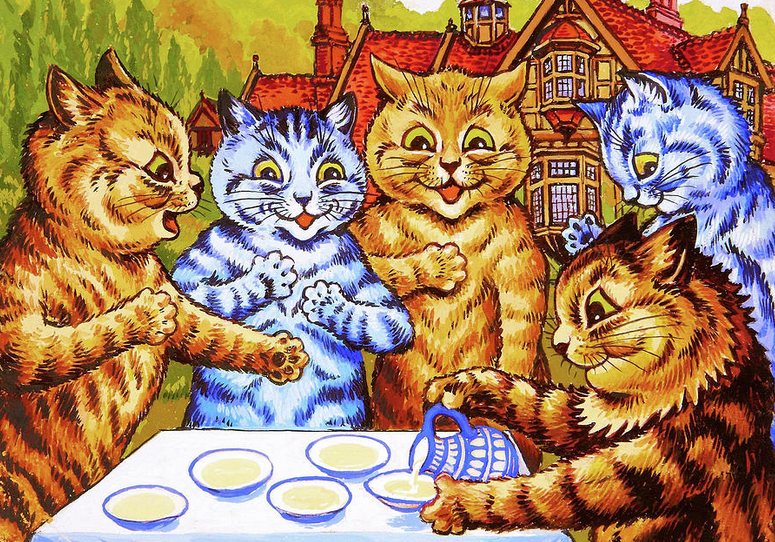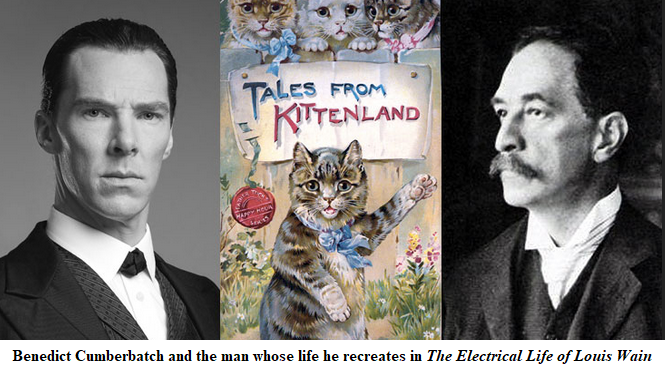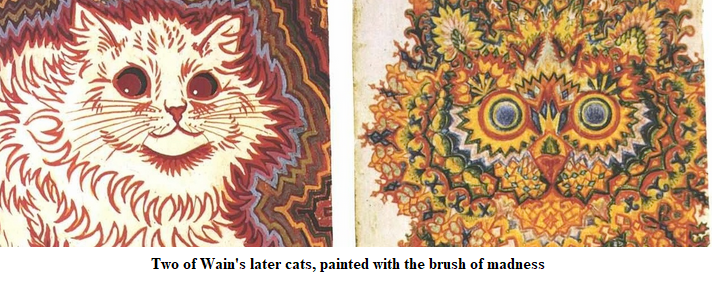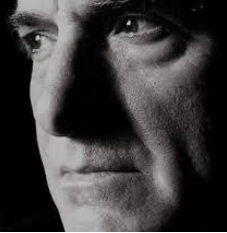
The scientists of today think deeply instead of clearly. One must be sane to think clearly, but one can think deeply and be quite insane. —Nikola Tesla
Many people believe that the fashion of keeping cats as house pets was popularised by the nineteenth-century English illustrator Louis Wain, whose colourful and gay anthropomorphised drawings of felines smoking pipes, pushing wheelbarrows, standing on their hind legs and reading magazines, in London’s top newspaper of the day, the Illustrated London News, made cats socially acceptable. (One of those illustrations is reproduced atop this page.) Before Wain, other than the odd secret cat club, which no one of respectable social standing belonged to, man’s best friend, the dog, was the traditional house pet, with most cats living as strays or mere mouse-catchers. In the 2021 British film The Electrical Life of Louis Wain, Louis Wain’s wife, Emily, tells him:
Throughout history, cats have been worshipped as mystical gods and maligned as the evil allies of witching and sin. But I think you are the first person ever to see that they are, in fact, ridiculous, they’re silly and cuddly, and lonely, and frightened and brave, like us. One day I don’t think that it’ll be so peculiar to have a cat in the house as a little pet.
The Electrical Life of Louis Wain is directed by Will Sharpe, story by Simon Stephenson, and with a screenplay co-written by them both. The emotive score, featuring the eccentric theramin mixed with traditional classical composing, is by the director’s younger brother, Arthur Sharpe.
This review appears in the latest Quadrant.
Click here to subscribe
The story opens with an elderly Louis Wain (played by Benedict Cumberbatch) in a mental asylum reflecting on his life. In a voice-over narration, we learn that the late-nineteenth-century society of Wain’s time was concerned with the novelty of electricity—and not just the electricity we are familiar with, but “a mysterious elemental form … shimmering in the æther—the key to all of life’s most profound and alarming secrets”.
There’s a flashback to a twenty-year-old Wain riding on a train and drawing on his sketch pad. A professional-looking man, sitting across the aisle, asks him how much he would charge to draw his small dog, Cleopatra. Wain does this for him for free.
Wain attends an interview at the Illustrated London News, edited by Sir William Ingram, and demonstrates his skill, and speed, by drawing the editor’s portrait with both of his hands at the same time, in under a minute. Impressed, Sir William offers him a permanent post but Wain turns it down due to a “commitment” to his work on several patents—including an electrical suit which he believes can cure mental illness. He is also trying to get an opera published, which, although he has no musical training, he has composed with his own invented conception of harmony. No one of standing in either of those professions takes his ideas seriously.
After his father dies in 1880, Wain becomes head of a household comprising his infirm mother and five sisters. His sister Caroline, who runs the house sharply, is explosively critical of Wain for his irresponsibility and flightiness.
A new governess, Emily Richardson (played by Claire Foy) is temporarily engaged to help with the younger children and Wain becomes infatuated with her. His attraction creates local gossip as she is from a lower class and a decade his senior.
Wain decides to accept the work offer at the Illustrated London News in order to afford to keep Emily on as full-time governess. He invites her and his sisters to the theatre to see The Tempest. But Caroline decides this blossoming relationship is unhealthy and dismisses Emily. Undeterred, Wain professes his love for her and, in 1884, they marry. He begins to earn a living taking private commissions as a dog portraitist. They have six months of blissful romantic marriage before she is given a grim diagnosis of terminal cancer of the breast.
One day they discover a stray kitten, which they take in. Keeping a cat indoors as a pet was unheard of at the time but they name it Peter and it becomes a surrogate child for them.

Wain is notified by Sir William that his work at the newspaper is to be cut back due to financial difficulties. He is advised to spend the extra time with his sick wife because “when she’s gone, it will hurt”.
Wain begins drawing their cat Peter to cheer his wife up through her illness and she suggests he show his illustrations to Sir William. The editor gives him a commission to fill the two centre pages of the Christmas issue with an array of his cats. Emily, growing weaker each day, comforts him:
No matter how hard things get, however much you feel that you’re struggling, the world is full of beauty and it’s up to you to capture it, Louie, to look, and to share it with as many people as you can. You are a prism through which that beam of light reflects.
After she dies, Wain buries his grief in an outpouring of cat illustrations that become enormously popular, completely altering the public’s perception of cats. His eccentricity, however, starts to become more like madness, and at a meeting of the National Cat Society, where he has recently been made chairman, he tells a curious member:
Cats will always prefer to face north especially because you’ll notice their whiskers act as antennae attracted to the positive poles of the earth. From the head right down to the tail, cats are excellent conductors of electricity. Their features are always changing and, as they become more domesticated and intelligent, their eyes will become larger and their heads bigger as their brains grow in size. They will turn blue and they will stand on their own hind legs and communicate to us in our own language.
The family becomes more destitute. Wain, despite his success, has failed to copyright his illustrations and is receiving no money for the many knock-offs and forgeries produced for sale.
His sister Marie develops leprosy. Sir William rents them one of his houses by the sea, at a reduced rate, to help Wain with her recuperation. In 1900 Marie is committed to an asylum, and Peter, his last link with Emily, dies.
He receives an opportunity to travel to New York to work for Randolph Hearst and has some luck there, but shortly after, his mother dies of influenza and Caroline asks him to return home.
In 1914 Marie dies of influenza and his long-time friend and employer, Sir William, of gout. The family falls further into debt.
Wain begins a futuristic and psychedelic cat series, which becomes the rage and generates a wide range of merchandising. This time he keeps control of the copyright but his entire cargo of stock is destroyed by a German U-boat.
Caroline grows ill and Wain begins to lose his mind. He is committed to the pauper’s ward of Springfield Mental Hospital, where no cats are allowed. An asylum official, Dan Rider, on a routine inspection, recognises him as the man he met years ago on the train from Andover, when Wain drew his dog Cleopatra.
With Wain’s three remaining sisters, Rider creates a fund to raise enough money to move him from Springfield to the world’s oldest psychiatric institution, Bethlem Hospital, in south London, and eventually to Napsbury Hospital, near St Albans, which has a large feral cat population. Napsbury is a quiet countryside facility that allows patients to keep cats as pets. He remains there in relative tranquillity for the rest of his life.
It is testimony to the consummate abilities of Foy and Cumberbatch that they are playing characters with an age difference of ten years—with Emily the elder—when in real life, Cumberbatch is almost a decade older than Foy.
In The Electrical Life of Louis Wain, the character of Dan Rider is portrayed as an asylum official who remembers meeting Wain years ago on a train, but in real life, Rider was a journalist and bookshop owner who discovered him drawing at an asylum. Their earlier encounter in the movie may have been artistic licence.
WAIN was committed to the pauper’s ward of the Springfield Mental Hospital in Tooting in 1924. When Rider discovered him there a year later, his circumstances were widely publicised, leading to appeals from such figures as H.G. Wells, and the concern of two prime ministers, Stanley Baldwin and Ramsay MacDonald.
The British government was in upheaval at the time. MacDonald had taken office as the first Labour Prime Minister on January 22, 1924, but by October, a general election was called and the Conservative Party under Stanley Baldwin won by a landslide. Five years later, Baldwin resigned and MacDonald again took office. MacDonald was a supporter of Wain’s work and organised a Civil List pension for his sisters, with memorial exhibitions held in 1931 and 1937.

Louis Wain died in 1939, at the age of seventy-nine, at Napsbury Hospital, and is buried in his father’s grave.
Lydia Figes of Art UK wrote:
The style of Wain’s cats was not directly influenced by a particular artistic movement or genre, though some have argued his eccentric style precipitated the arrival of abstraction. Due to the detachment from any artistic school or movement, Wain has also been categorised as an outsider artist, a term coined by Roger Cardinal in 1972.
The entrepreneur Elon Musk is the co-founder of Tesla, an American electric-vehicle and clean-energy company with a market capitalisation of nearly US$1 trillion. The name of the company is a tribute to Nikola Tesla, the nineteenth-century Serbian-American inventor, electrical engineer and futurist. Tesla was well-known as a showman, giving lectures on his experiments with wireless electric power throughout the late 1890s and early decades of the twentieth century.
Today there are seven ways of generating practical electricity: electricity created by rubbing, by chemical action, by the action of light, by heat action, by magnetism, by pressure and by water action. There is a profound difference between electricity as we commonly think of it and the way progressive society in Louis Wain’s day imagined it.
Tesla once said: “If you want to find the secrets of the universe, think in terms of energy, frequency and vibration.” H.P. Blavatsky, known as Madame Blavatsky, was a Ukrainian writer who co-founded the Theosophical Society in New York in 1875 and was its leading theoretician. In 1885 she moved to London and established the controversial Blavatsky Lodge. She died of influenza during the global 1889-90 flu pandemic. Blavatsky used the term Fohat—an occult Tibetan term for Daiviprakriti, or primordial light—to describe this cosmic or universal electricity, vitality, energy and life force. In 1888, she wrote:
Some faint idea of the nature of Fohat may be gathered from the appellation “Cosmic Electricity” sometimes applied to it; but to the commonly known properties of electricity must, in this case, be added others, including intelligence. It is of interest to note that modern science has come to the conclusion, that all cerebration and brain-activity are attended by electrical phenomena.
Science in our time has also demonstrated that the human nervous system is chemical and electrical in nature. According to the US National Library of Medicine National Institutes of Health, “The nerve cell, or neuron, is the key player in the activity of the nervous system. It conveys information both electrically and chemically. Within the neuron itself, information is passed along through the movement of an electrical charge (i.e., impulse).”
I think the most useful way of understanding Wain’s perception of electricity is found in one of Dan Rider’s closing monologues to him at the Springfield institution:
I think Emily wanted you to keep painting so you would not be alone. When you paint you create with other people—you give them a piece of your soul but they are also connecting with you in that “electricity” that you describe, that you felt in the presence of Emily. I’d call that love, Mr Wain. And that’s still here.
Xenophanes originated the word anthropomorphism to describe the perception of a divine being in human form. Anthropomorphism is present in all religious teaching and mythology. But one of the inherent dangers of over-projecting human characteristics or psychological states into cats and other animals—known as abstract anthropomorphism—is its reverse state, dehumanisation, the tendency in times of extreme crisis or desperation to view humans as non-human objects or animals. What that renowned Swiss psychoanalyst and cat connoisseur Carl Gustav Jung might have called the Shadow of the Kitty.
I once extracted a cuddly-looking doe-eyed possum by its tail from the eaves of a bush house and watched it transform from a cute Disney child’s toy into the Bride of Chucky in five seconds, whipping around and carving four long gashes in my forearm. And it urinated on me as well.
While I was rewatching The Electrical Life of Louis Wain, and taking notes for this article, I noticed our own friendly neighbourhood black cat, who often sleeps outside on our veranda, on the windowsill. He comes freely into the house, through open windows and doors, looking for mice and food scraps. He’s always welcome, we enjoy his company and some serious cat owners have called us “cat uncles: all of the benefits and none of the responsibilities”. That may be so, but the cat seems to like this arrangement! Louis Wain once said, “Intelligence in the cat is underrated.”
The cat was quietly sitting outside the window staring at the television screen. I looked over at him and he looked back at me and I somehow felt that this could possibly be the electrical spirit of Louis Wain encouraging me on
 Sign In
Sign In 0 Items (
0 Items ( Search
Search










Sounds like a fascinating film based on a gifted, eccentric man who experienced many tragedies. Thank you for the alert.
Thank you, Joe